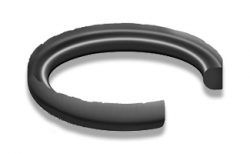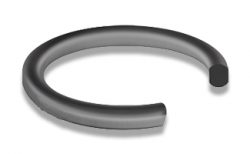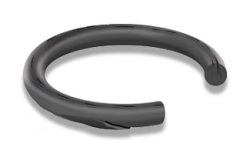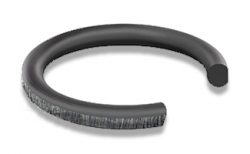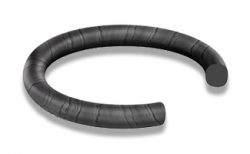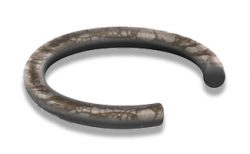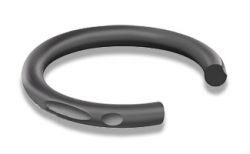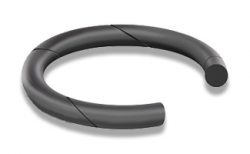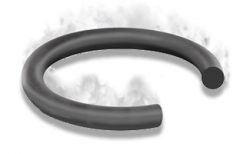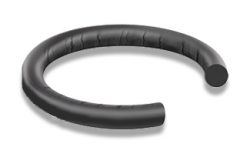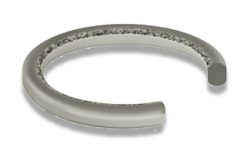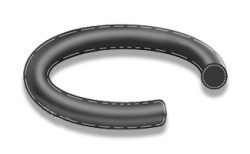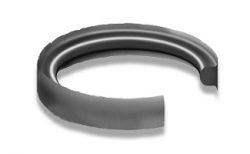Why Do O Rings Fail?
O Ring Failure Guide
O Ring failure often occurs too soon in applications due to inadequate gland design or compound choice. This article will explain why O Rings fail by supplying examples of general damage modes. In order to improve seal execution, it is necessary to correctly and effectively identify the damage mode.
No matter how careful we are during the design phase, O Rings can fail in their application for various reasons. The number of pressures that affect O Rings can be very hard to assess which is why it is extremely important to re-test every material in its original environment and precisely examine them throughout the installation stages.
The O Ring Failure Guide below provides details of some of the most popular O Ring failure modes:
O RING FAILURE 1:
EXTRUSION AND NIBBLING
Description & Visual Indications:
Extrusion is the process where high stresses force material into the clearance gap, then pulses of high pressure cause the clearance gap to open and close, trapping the O Ring between the mating surfaces which results in physical damage to the seal surface. The edges of the O Ring are nibbled, chipped or ragged (usually on the low-pressure side). In severe cases, shaving can occur and the surface may be peeled off.
Contributing Factors/Failure Analysis:
Excessive pressure, Excessive clearances, Excessive gland fill, Irregular clearance gaps, Sharp gland edges, Improper O Ring size installed causing excessive filling of grove, O Ring material too soft, Degradation of O Ring material by system fluid (cracking, shrinking, swelling, softening etc), Improper machining of O Ring gland.
Prevention & Suggested Solutions
Increase rigidity of metal components, Decrease sharp edges of the gland to a minimum, Reduce back clearance gaps by using backup devices, Decrease clearance by reducing machining tolerances, Appropriate gland design, Compatibility of an O Ring material with system fluid, Installation of adequate O Ring size, Use of the harder seal material.
O RING FAILURE 2:
COMPRESSION SET
Description & Visual Indications:
Compression set is one of the most common O Ring failures. An efficient O Ring seal needs a continuous ‘seal line’ between the sealed surfaces which is a function of gland design and seal cross-section. To maintain seal integrity without excessive deformation of the seal, the ‘seal line’ establishes the correct amount of compression on the O Ring. O Ring becomes less circular and has flattened surfaces (flat sided oval), it has taken the shape of the groove and it is unable to recover to its original shape.
Contributing Factors/Failure Analysis
Physical and chemical changes appear, Excessive compression/over tightening, Improper gland design, Excessive temperature, which caused the O Ring to lose its elastic properties, Elastomer with high compression set, O Ring volume swell because of system fluid, Elastomer incompletely cured during production, Poor compression set properties of material selected, Fluid incompatible with O Ring material, O Ring losing its elasticity due to cross-link density increase.
Prevention & Suggested Solutions
Selection of elastomer materials with low compression set, Confirm material compatibility with intended service conditions, Confirm the O Ring is not over-squeezed, Check gland design, Use more flexible polymer structure, Lower system operating temperature, Reduce excessive frictional heat build-up at seal interface.
O RING FAILURE 3:
EXPLOSIVE DECOMPRESSION
Description & Visual Indications
After a period of time in service (under high-pressure) the pressure may decrease too quickly. The gas is then absorbed and expands very fast and blisters and ruptures the elastomer surface. Excessive trapped gas may result in total destruction of an O Ring. Blisters and cracks on the surface due to absorption of gas at high pressure and the subsequent fast drop in pressure. Surface marked with deep splits. Splits and fissures revealed after examination of internal structure. In severe cases, the surface is completely ruptured.
Contributing Factors/Failure Analysis
Rapid pressure changes, Low hardness elastomer.
Prevention & Suggested Solutions
Slower decompression allows trapped gas to escape from seal material, Higher hardness elastomer, Reduce temperature, Choose ED-resistant material, Right selection of seal material – explosive decompression resistant, Consider using metallic O Ring or C Ring.
O RING FAILURE 4:
ABRASION
Description & Visual Indications
Abrasion is another common type of seal failure. Mostly it’s found in dynamic seals due to rotary motion, oscillating and reciprocating. Flat area on the side of an O Ring where it was touching the dynamic surface. Grazed lines on the flat surface parallel to the direction of motion. Only one side of the seal will be worn. Seal surface may have some loose particles and scrapes. Excessive wear – lacerations may be deeper and there may be breaking in places.
Contributing Factors/Failure Analysis
Repetitive friction between O Ring surface and the housing, Dynamic motion, Improper lubrication, Improper finish of the surface in dynamic contact with the O Ring (the surface may be abrasive, too smooth or too rough due to inability to hold lubricant), Excessive temperature, Process environment containing abrasive particles, Poor elastomer surface finish.
Prevention & Suggested Solutions
Adequate lubrication, Use O Ring sealing materials with improved abrasion resistance, Eliminate abrasive components, Use of recommended gland surface finishes, Eliminate the source of contamination, Use of wiper or scraper rings will reduce contamination of the seal, Consider use of internally lubricated O Rings – this will reduce friction and wear.
O RING FAILURE 5:
THERMAL DEGRADATION
Description & Visual Indications
Thermal Degradation is frequently accompanied by compression set, Radial cracking (on surfaces dealing with highest temperatures), Surface becomes shinier in places which is a sign of softening.
Contributing Factors/Failure Analysis
Thermal properties of the elastomer, Temperature of an application has exceeded maximum temperature ceiling of the seal material, Excessive temperature cycling has occurred, Increase in hardness and modulus which makes seal less elastic.
Prevention & Suggested Solutions
Choose an elastomer with enhanced thermal stability, Possible cooling sealing surfaces.
O RING FAILURE 6:
UV DEGRADATION
Description & Visual Indications
Discolouration of an exposed surface of an O Ring, Cracking due to excessive exposure to prone materials, Disintegration (in worst cases).
Contributing Factors/Failure Analysis
Ultraviolet light exposure (due to UV having a short wavelength which interacts with the molecular structure of the exposed part), This usually causes cleavage of the polymer and results in cracking of the surface, This then leads to leaking premature failure.
Prevention & Suggested Solutions
Black and fluorinated materials show higher resistance.
O RING FAILURE 7:
INSTALLATION DAMAGE
Description & Visual Indications
Small cuts, nicks or gashes on the seal.
Contributing Factors/Failure Analysis
Sharp edges of glands, threads or components, which may damage O Ring during assembly, Wrong sizing of O Ring, Low hardness elastomer, Elastomer surface contamination, Improper lubrication before installation.
Prevention & Suggested Solutions
Remove all sharp edges, Proper gland design, Proper elastomer sizing, Ensure all components are clean before installation, Use of lubricant, Higher hardness elastomer.
O RING FAILURE 8:
SPIRAL TWISTING FAILURE
Description & Visual Indications
Cuts or marks which spiral around seal circumference, Spiralling pattern around its exterior with subsequent deep cutting.
Contributing Factors/Failure Analysis
O Ring is both sliding and rolling at the same time, Slow reciprocating speed, Improper installation, Irregular seal surface finish, Excessive gland width, Low hardness elastomer, Uneven or rough gland surface finish, Insufficient lubrication, Eccentric components, Friction.
Prevention & Suggested Solutions
Correct installation procedures, Possible use of polymer backup rings, Higher hardness elastomer, Proper gland surface finish, Adequate gland design, Internally-lubed elastomers or properly lubricated elastomer.
O RING FAILURE 9:
OUT-GASSING
Description & Visual Indications
Parts of seal formulation, decomposition products of the ingredients or other gasses trapped in the polymer matrix during the moulding process can be released under vacuum conditions. Usually no visible signs, In extreme cases, shrinkage can be seen, Decrease in cross-sectional size.
Contributing Factors/Failure Analysis
Inadequately cured seal, Low hardness/plasticized seal, High vacuum levels.
Prevention & Suggested Solutions
Making sure the seals are properly post-cured, Avoid plasticised elastomers, Using materials with a pure polymer, Using materials for the correct temperature.
O RING FAILURE 10:
CHEMICAL DEGRADATION
Description & Visual Indications
Cracks, blisters or even discolouration, In some instances, the degradation is only observable by measuring of physical properties, Change in hardness, Loss of original shape and integrity.
Contributing Factors/Failure Analysis
Incompatibility with the chemical and/or thermal environment, Increase in cross-link density, Hard and brittle material reduces the ability to provide reaction force, Chain scission results in a reduced strength.
Prevention & Suggested Solutions
Selection of more chemically resistant seal, Correct elastomer material, Correct temperature.
O RING FAILURE 11:
PLASMA DEGRADATION
Description & Visual Indications
The high energy ionised gasses or radicals that the plasmas consist of, attack the organic backbone of the material and form small particles or molecules. Discoloration, Erosion of seal in the exposed areas, Even material loss on the surface which touches the plasma, Powdered residue on the surface.
Contributing Factors/Failure Analysis
Chemical reactivity of the plasma, Improper gland design, Ion sputtering, Incompatible seal material, Electron heating.
Prevention & Suggested Solutions
Plasma-compatible elastomer and compound, Minimise exposed area, Examine gland design, Seal damage is unavoidable with long-term exposure to plasma.
O RING FAILURE 12:
CHEMICAL SWELL
Description & Visual Indications
Seal seems larger than its original dimensions, Swelling may appear on the whole seal or just parts exposed to a chemical.
Contributing Factors/Failure Analysis
Ingress of media into the seal due to a chemical resemblance of the media and the compound, Elevation of seal volume can lead to gland fill, loss of sealing or extrusion, Loss of physical features such as tensile durability.
Prevention & Suggested Solutions
Check the chemical compatibility of the seal material, Use seal with proven resistance to chemical environment.
O RING FAILURE 13:
THERMAL EXTRUSION
Description & Visual Indications
Seal no longer have a round profile, Seal takes shape of the groove, A ‘frilly’ edge will appear on two opposing sides.
Contributing Factors/Failure Analysis
Thermal expansion of a seal is usually much higher than that of adjacent hardware, The volume of a seal at raised temperatures will have increased much more than that of the material around it, At raised temperatures, a seal can fill the groove and afterward expel into the clearance gaps.
Prevention & Suggested Solutions
Advance groove/gland design to let adequate space to place extra seal volume at raised temperatures.
M Barnwell Services is the UK’s largest independent stockist, manufacture, and distributor of fluid sealing products and services. For more information about Barnwell O Rings click here
For more information on our range of products click here.
E & OE. M Barnwell Services endeavours to make sure all the content is correct. Information has been gained from manufacturing partners.
